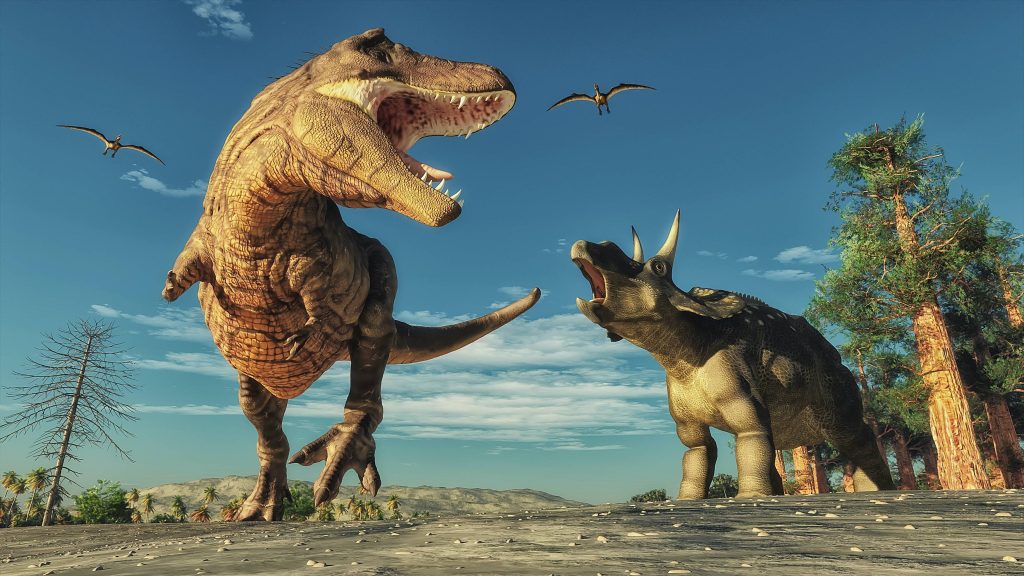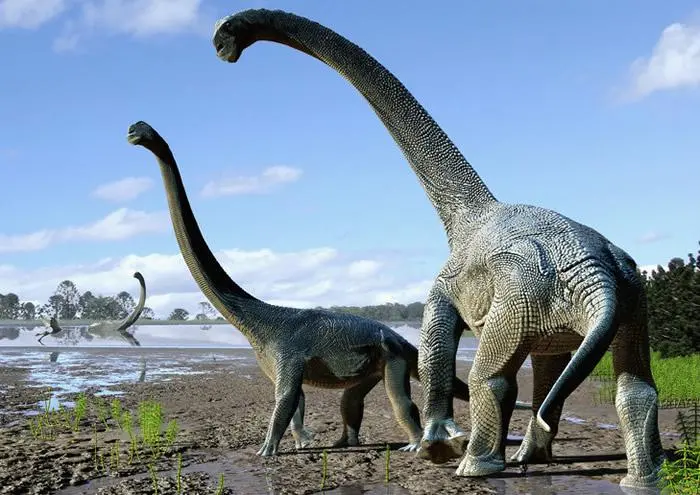The claim that the word “dinosaur” was coined before the first dinosaur fossils were discovered, thereby suggesting that prehistoric reptiles never existed, is a fallacious argument that disregards the extensive scientific evidence supporting the existence of dinosaurs.
This claim has resurfaced in contemporary discourse, propagated through social media platforms and perpetuated by individuals who seek to cast doubt on established scientific knowledge.
However, a comprehensive examination of historical and scientific facts unequivocally refutes this erroneous assertion.
Contrary to the aforementioned claim, the assertion that dinosaurs never existed is unequivocally false. The discovery of dinosaur fossils predates the coining of the term “dinosaur” and has been documented throughout human history.
The recognition of these ancient reptiles dates back thousands of years, with various cultures encountering and interpreting the remnants of these prehistoric creatures.
Moreover, the significance of dinosaur fossils was acknowledged in the early 19th century when an English surgeon and his wife unearthed dinosaur teeth in a forest south of London in 1822.
This discovery played a pivotal role in advancing the understanding of dinosaurs and their place in Earth’s history.
The term “dinosauria,” meaning “terrible lizard,” was subsequently coined by an English anatomist and paleontologist in 1842.
This nomenclature was not a product of deceit or desperation, as suggested by the fallacious claim, but rather a scientific classification that aimed to categorize and understand the unique characteristics of these ancient creatures.
The naming of dinosaurs was rooted in a rigorous scientific inquiry and a genuine pursuit of knowledge, devoid of the ulterior motives attributed to it by those who seek to discredit the existence of dinosaurs.
The fallacious claim also misrepresents the intentions of Sir Richard Owen, the individual credited with coining the term “dinosauria.”
The insinuation that Owen sought to prove evolution true through the invention of dinosaurs is a distortion of historical facts and lacks substantiated evidence.
Sir Richard Owen was a respected scientist whose contributions to paleontology and comparative anatomy significantly enriched the understanding of prehistoric life.
His endeavors were driven by a commitment to scientific inquiry and a genuine desire to unravel the mysteries of Earth’s ancient inhabitants.
Furthermore, the claim’s reliance on the timing of the first dinosaur discovery in 1858 to cast doubt on the existence of dinosaurs is a flawed argument.
The chronological sequence of scientific discoveries does not negate the wealth of evidence amassed over centuries that unequivocally establishes the existence of dinosaurs.
The discovery of the first complete dinosaur skeleton in 1858, known as the Hadrosaurus foulkii, marked a significant milestone in paleontological research and further solidified the scientific understanding of dinosaurs.
In conclusion, the claim that the word “dinosaur” was coined before the first dinosaur fossils were discovered, thereby suggesting that these prehistoric reptiles never existed, is patently false.
The existence of dinosaurs is supported by an extensive body of scientific evidence, including the discovery of dinosaur fossils dating back thousands of years and the meticulous efforts of pioneering paleontologists and scientists.
The fallacious nature of this claim underscores the importance of critically evaluating information and adhering to established scientific knowledge.
Denying the existence of dinosaurs based on a misinterpretation of historical events and scientific advancements is a disservice to the pursuit of knowledge and the enduring legacy of these magnificent creatures.
In the face of overwhelming evidence, it is imperative to reject unfounded claims and uphold the integrity of scientific inquiry.
The study of dinosaurs continues to captivate and inspire, offering profound insights into the Earth’s rich history and the remarkable diversity of life that has inhabited our planet.
As we navigate the complexities of contemporary discourse, let us remain steadfast in our commitment to truth, reason, and the enduring legacy of scientific discovery.
The concept of dinosaurs has long captivated the human imagination, with their colossal size, fearsome appearance, and mysterious extinction sparking fascination and speculation for centuries.
The recent emergence of the “dinohoax” meme, featuring a Tyrannosaurus rex image and the enigmatic term, has reignited discussions surrounding the history and perception of these ancient creatures.
While the origins of this meme remain shrouded in mystery, its presence in online spaces since 2019 underscores the enduring interest in dinosaurs and the ongoing evolution of public discourse on the subject.
The term “dinosauria” was introduced by English anatomist and paleontologist Richard Owen in 1842 to classify three distinct types of extinct reptiles that had been formally identified in the early 1800s.
This pivotal moment in scientific nomenclature marked the formal recognition of dinosaurs as a unique group of prehistoric animals.

However, the existence of fossilized dinosaur remains predates this formal classification, with evidence of human encounters with dinosaur fossils stretching back through the annals of history.
Experts assert that despite the lack of widespread recognition, dinosaur remains have been unearthed and documented by various civilizations for millennia.
Bruce Lieberman, director of the University of Kansas’ Paleontological Institute, highlighted the enduring human interest in fossils, particularly those of dinosaurs, dating back thousands of years.
This enduring fascination with ancient creatures is further supported by archaeological and other forms of evidence that suggest early civilizations possessed an awareness of creatures that would later be classified as dinosaurs.
The discovery of a Native American pictogram depicting a giant bird, dated to around 500 A.D., in close proximity to dinosaur footprints serves as a poignant example of the longstanding human interaction with prehistoric relics.
This convergence of ancient art and fossilized evidence hints at the deep-rooted fascination and recognition of these ancient creatures by early societies.
Furthermore, the pioneering work of Gideon Mantell, an English surgeon, and his wife Mary Ann Mantell, who are widely acknowledged as the first to approach dinosaur fossils from a modern scientific perspective, underscores the enduring human curiosity surrounding these ancient beings.
The Mantells’ groundbreaking discovery of dinosaur teeth in Tilgate Forest in 1822 marked a turning point in the scientific understanding of dinosaurs, laying the foundation for subsequent paleontological research and discoveries.
Their recognition of the significance of these fossils as belonging to a distinct group of reptiles paved the way for the formal classification and study of dinosaurs.
This pivotal moment in the history of paleontology represents a crucial milestone in humanity’s evolving relationship with dinosaurs, shaping our understanding and appreciation of these enigmatic creatures.
In conclusion, the “dinohoax” meme, while enigmatic in its origins, serves as a catalyst for renewed contemplation of humanity’s enduring fascination with dinosaurs.
From the pioneering work of early paleontologists to the longstanding human interaction with fossilized remains, the history of dinosaurs is intertwined with the fabric of human curiosity and discovery.
As we continue to unravel the mysteries of the prehistoric world, the enduring allure of dinosaurs persists, captivating generations with their ancient majesty and sparking ongoing conversations about their place in our collective consciousness.
This essay delves into the historical context of dinosaur discovery and the enduring human fascination with these ancient creatures, shedding light on their significance and the evolving perceptions surrounding them.
The “dinohoax” meme, with its cryptic imagery and enigmatic message, serves as a springboard for contemplation of the rich tapestry of human engagement with dinosaurs, prompting reflection on their enduring impact on our collective imagination and scientific understanding.
The discovery and classification of dinosaurs have long captivated the imagination of scientists and laypeople alike.
The story of how these ancient creatures were first identified, described, and named is a fascinating tale that sheds light on the early days of paleontology and the scientific process.
This essay aims to explore the historical significance of the naming of the first extinct animals, particularly the role of Gideon Mantell and Richard Owen in this pivotal moment in the field of evolutionary biology.
In 1825, Gideon Mantell published a groundbreaking paper in which he identified fossilized teeth resembling those of living iguanas.
This discovery led Mantell to name the creature to whom the teeth belonged “iguanadon.” This marked the first formal identification, description, and naming of an extinct animal.
Subsequently, Richard Owen, a prominent British biologist of the mid-1800s, coined the term “dinosauria” to describe iguanadon and two other creatures—megalosaurus and hylaeosaurus—identified around the same time.
Matt Friedman, director and associate curator at the University of Michigan’s Museum of Paleontology, emphasized the significance of Owen’s work, noting that the differences between these ancient creatures and “ordinary” reptiles led Owen to establish the dinosauria as a distinct group.
This move represented a crucial step in the classification and understanding of extinct animals. Furthermore, it is noteworthy that Owen’s coinage of the term “dinosauria” occurred nearly 30 years before the publication of Charles Darwin’s “On the Origin of Species,” a seminal work in evolutionary biology.
Friedman also addressed misconceptions about Owen’s motivations, highlighting that Owen was not “desperate to succeed” as some claims suggest.
On the contrary, Owen was a prominent figure in the scientific community, and his contributions to the field of biology were significant in their own right.
This clarification serves to underscore the importance of recognizing Owen’s role in the early development of paleontology and evolutionary thought.
The naming of iguanadon and the establishment of the dinosauria as a distinct group of ancient creatures represent pivotal moments in the history of paleontology and evolutionary biology.
These events laid the groundwork for subsequent discoveries and advancements in our understanding of prehistoric life.

The legacy of these first extinct animals continues to inspire awe and curiosity, fueling ongoing research and exploration in the field of paleontology.
The naming of iguanadon and the establishment of the dinosauria by Gideon Mantell and Richard Owen stand as seminal achievements in the history of paleontology.
These events marked the formal recognition of extinct animals and contributed to the development of evolutionary thought.
By dispelling misconceptions about Owen and highlighting the significance of his contributions, we can gain a deeper appreciation for the historical context in which these discoveries took place.
The legacy of the first extinct animals endures as a testament to the enduring fascination with the ancient past and the ongoing quest to unravel the mysteries of prehistoric life.
